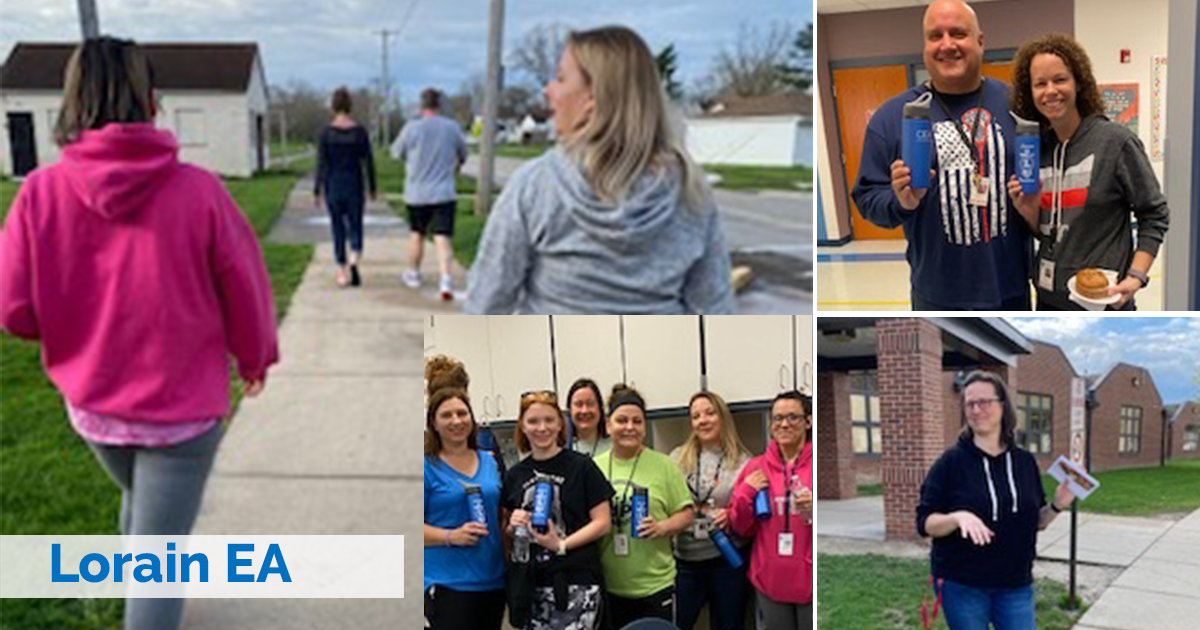Wellness Grant
OEA’s Wellness Grants Help Locals Support Member Well-Being
- Up to $5/per Active Member
- Submission and Approval of Application Required
- Activity Must be completed between September 3, 2024 – May 31, 2025
- Receipts must be submitted for Reimbursement by June 15, 2025
- Share photos with LRC to post on the OEA Wellness Website
- Contact LRC for Application
- Share your events on social media using #OEAWellnessGrant, #OEAWG, and #OEAWellness
- Click here to download a Wellness Grant application
- Wellness Grants Funds cannot be used for the following: T-shirts, Gift Cards/Gift Certificates, Cash Gifts to Members, or Lottery Tickets
WELLNESS GRANT ACTIVITIES
- Laughter As The Best Medicine – Set a movie event for members. A comedy or light-hearted movie is suggested. Provide members with movie “snacks” as they share an opportunity to laugh alongside fellow members.
- Social Time Members Uplifting Members – Organize an event – perhaps a happy hour or coffee chat – where members can relax and spend time together in a social setting.
- Pop-up Café – Set up a pop-up café that offers members snacks and positive messages. The café could be as simple as a table staffed by other members or a coffee/tea bar.
- Drop-in Spa – Create a drop-in spa for members in buildings. Members can sign up for time to experience a relaxing environment with a massage chair, healthy snacks, and beverages.
- Wellness Passport/Self-Care BINGO – Provide members with a Wellness Passport with pages to be stamped for each self-care activity they do on their own. Create a BINGO card with self-help activities for members to complete. The activities for the passport or BINGO card could include such things as: exercise classes, virtual challenges, book clubs, and meditation. Award members with a gift with a completed passport or completed BINGO card.
- Special Delivery! – Create a monthly drawing for all members. Winners will receive a special delivery of flowers, cookies, candy, self-care bags, or books, and a positive message from their local.
- Lunch and Learn – Invite members to an hourlong lunch and training focused on a wellness activity or skill such as meditation or an art/craft. The lunch hour could include a speaker on a topic related to self-care. Ask members to complete a self-care survey during the lunch and learn.
- Keep Active and Be Healthy Challenges
• Walk/Step Challenge – Provide each member who signs up for the challenge with a promotional Local water bottle, notebook, pen, and information on the health benefits of walking. Create a members-only Facebook or Instagram page for the challenge. Ask participating members to set a personal goal for the 30-day challenge, keep track for 30 days, and post/share positive thoughts via social media.*
• Sleep Challenge – Provide each member who signs up for the challenge with a sleep mask, earplugs, herbal tea, notebook, and information on the health benefits of sleep. Create a members-only Facebook or Instagram page for the challenge. Ask participating members to set a personal goal for the 30-day challenge, keep track for 30 days, and post/share positive thoughts via social media.*
*Members who complete the 30-day challenge receive a certificate and gift - Local’s CHOICE! – Develop a Wellness Themed Activity of your own!
“I got great feedback from some staff that said they appreciated the nice surprise on a cold Monday morning – a goodie bag with items with a note attached explaining how each item can be applied to their own personal wellness”
A sample of locals who have received a Wellness Grant
American Education Week — Keeping Students Safe & Secure
During American Education Week (Nov. 12-16, 2018), the Ohio Education Association is taking the opportunity to raise awareness of, and to help eliminate, the stigma of managing a disability or a mental illness.
[Video: Keeping Students Safe — Andrea Beeman, Special Education Paraprofessional, OEA/Maple Org. Support Team]
Each morning, millions of school children face the challenge of living with an impairment, mental illness or disability.
Conditions range from Attention-deficit/hyperactivity disorder, drug dependency, and depression to varied spectrum disorders.
Despite their prevalence, unwarranted assumptions and avoidance by other are also, unfortunately, widespread.
Accordingly, the OEA has called upon state lawmakers to implement a comprehensive school safety strategy that includes meeting mental health needs in schools by providing appropriate supports for our students.
These strategies must not only include essential physical security issues, but also addressing mental health in our curriculum, and appropriate staffing and student support in the form of adequate numbers of counselors, nurses, social workers, and mental health specialists to ensure that all students’ needs are met.
Similarly, the OEA has recently:
- Opposed a plan to use federal funds to buy guns for teachers;
- Sponsored the 2018 National Dropout Prevention Network Conference; and,
- Advocate for programs that establish and support safe learning environments that are free of crime, drug use, and other disruptions.
To learn more about where OEA members collectively stand on the issues, click here! | #WeLoveOurESP | #AEW2018
Medicaid keeps many Ohio public school students healthy
by Becky Higgins, OEA President
 They have books, pencils and a backpack. But will Ohio’s public school students continue to have health care? Maybe or maybe not. It depends on what Congress and the President decide to do about Medicaid.
They have books, pencils and a backpack. But will Ohio’s public school students continue to have health care? Maybe or maybe not. It depends on what Congress and the President decide to do about Medicaid.
About 40 percent of Ohio children receive their health coverage from Medicaid. And in some Ohio school districts, that percentage is even higher. In the Dayton City Schools, 71.7 percent of students are on Medicaid. In Youngstown, 80.5 percent of students are enrolled in Medicaid. In Cleveland, it’s 72.7 percent.
Countless studies have shown that children who have access to regular, consistent health care do better in school. Medicaid is critical to ensuring that Ohio’s public school students have quality health care. Children who receive health care through Medicaid are more likely to graduate from high school, finish college, have fewer hospitalizations and enjoy better health as adults. Children who have Medicaid are less likely to drop out of school, engage in risky sexual activity, smoke, or be overweight. And Medicaid gives struggling families the security of knowing that their household budgets.
No child should be without health coverage and access to needed health care. Medicaid makes that possible in Ohio.
Medicaid is a lifeline that keeps a majority of children healthy in many Ohio counties. Medicaid improves academic performance and attendance. It helps ensure that children receive timely and appropriate care, and can help address behavioral issues including the impact of trauma that poses challenges to the proper learning environment.
In the 1980s and 1990s, researchers studied a group of students to determine the long-term effects of healthcare coverage on education. They found that a 10 percent increase in Medicaid eligibility for kids up to the age of 17 led to a smaller high school dropout rate, greater enrollment in college and a higher percentage who earned a four-year college degree.
Medicaid coverage not only improves children’s health and educational attainment it also enhances their earnings potential. People covered by Medicaid during childhood are healthier adults, with fewer hospitalizations and emergency room visits and higher incomes as adults, studies shows.
And while many districts struggle with financial challenges, Medicaid contributes more than $80 million to Ohio’s public schools to pay for needed services for students with disabilities. These are services that schools are required to provide and Medicaid offers a reliable funding stream to help pay for them.
The bottom line is that Ohio schools and taxpayers win when children in Ohio have Medicaid. In this time of uncertainty about what Congress and the President might do to change Medicaid, it is important that Ohioans let their representatives in Washington know that Medicaid should be protected.
Spotlight on Women’s Health
- President Obama expands women’s access to preventative services. Under the Affordable Care Act (ACA), most health insurance plans will cover women’s preventive services – including well women visits, and domestic violence screenings – without charging a co-pay or deductible.[1] This new law will save money for millions of Americans and ensure Americans nationwide get the high-quality care they need to stay healthy.[2] The President also passed landmark health care reform. The Affordable Care act expanded health care coverage to 32 million Americans.[3] Now young adults can be covered by their parents’ insurance plans until age 26, and 2.5 million young adults have already taken advantage of this provision of the law.[4] It also stops insurance companies from denying coverage based on preexisting conditions or dropping individuals when they get sick.[5]
*******
- Romney promises to eliminate key women’s health programs. “Number one on my list: Obamacare – I’ll get rid of that on day one.”[6] Romney has made continued pledges to eliminate the Affordable Care Act (ACA) during the campaign. Before the ACA became law, women could be charged more for individual insurance policies because of their gender. The ACA also guarantees mandatory maternity coverage for all women, as well as recommended preventive services including PAP tests, mammograms, new baby care and well-child visits, with no out-of-pocket costs. Romney has also pledged to “eliminate Title X family planning programs”[7] Title X covers reproductive health services including birth control, STD screenings, and cervical-cancer exams for low-income women.
- Santorum invents facts, slams the ACA. Santorum recently claimed “ties [between] cancer and abortion”[8] (ties which have been disproved in peer-reviewed studies). These statements follow a string of comments opposing women’s healthcare advances. Discussing the popular components of the ACA – including requiring coverage for women regardless of preexisting conditions (including pregnancy) – Santorum said “That’s something that everybody thinks is so popular,” he said. “But it also leads to enormous cost.”[9] Echoing Romney, Santorum’s “Priority number 1 = repeal Obamacare.”[10] Santorum’s proposed alternatives include no additional rules to protect the ACA’s protected coverage for women.
NEA Believes
- Affordable, comprehensive health care is the right of every resident. President Obama’s historic legislation moves the country closer to more comprehensive health care coverage; controlling costs while assuring quality; emphasizing preventative care; and assuring greater equity in the funding and access of that health care. The Affordable Care Act has opened up preventative care services to an estimated 54 million Americans, including 20 million women.[11]
- Additional federal resources should be devoted to the study of women’s health related issues as well as ensuring that all women have access to full coverage of their reproductive health care needs.
[1] “Women’s Preventive Services and Religious Institutions,” WhiteHouse.gov, February 10, 2012.
[2] “Women’s Preventive Services and Religious Institutions,” WhiteHouse.gov, February 10, 2012.
[3] “Health Reform in Action,” WhiteHouse.gov.
[4] “Health Reform in Action,” WhiteHouse.gov.
[5] “Health Reform in Action,” WhiteHouse.gov.
[6] http://www.youtube.com/watch?feature=player_embedded&v=JtxAvAgrMVU.
[7] HOW I’LL TACKLE SPENDING, DEBT, MittRomney.com, 11/3/2011.
[8] Santorum suggests abortion causes breast cancer, The Raw Story, 2/5/2012.
[9] Rick Santorum hits even popular parts of the ACA, Politico, 2/6/2012.
[10] Santorum on health care: Not much to write home about, My San Antonio, 2/14/2012.
[11] Fifty-Four Million Additional Americans Are Receiving Preventive Services Coverage Without Cost-Sharing Under The Affordable Care Act, U.S. Department of Health and Human Services, 2/2012.
Health Care Reform Petition
Please sign NEA’s petition to tell your elected leaders that we need health insurance reform and we need it now! The cost of inaction is too high! Too many of our fellow Americans are uninsured, delay needed care because they can’t afford it and must often file for bankruptcy due to medical bills they can no longer afford to pay.
H1N1 Lesson Plan
PBS has crafted some lesson plans on H1N1, designed for grades 10-12 in Secondary Life Science, Biology, Health, and Current Events – https://www.pbs.org/education/. Students will:
- Utilize prior knowledge to answer questions about viruses and form a definition of the term virus.
- Participate in a class simulation to learn about how viruses spread, often without the knowledge of those who are infected.
- Discuss what they know about H1N1 flu, sometimes called swine flu and check the accuracy of their facts using primary sources related to the topics and classroom discussion activities.
- Examine the process used for developing disease fighting vaccines using primary sources and classroom discussion activities.
- Create projects that illustrate what they have learned about viruses, H1N1 flu, and the threat of a worldwide pandemic.
- Share their projects with classmates to demonstrate their learning.
Are you planning any lessons on flu? Teaching students how to properly wash their hands? Or perhaps a lesson on pandemics? Share your ideas and resources with colleagues.
Health Care: Reality Check
The statistics on the cost of health care in this country are grim to say the least. Over the past eight years health insurance premiums for Ohio working families have increased 76 percent, outpacing median earnings by 850 percent, which only rose 8.9 percent over that time.
Even people with health insurance are paying more out of pocket for their health care. Nearly nine out of 10 people with insurance are spending more than 10 percent of their pre-tax income on health care costs. More than four in five people who have insurance are spending over 25 percent of their pre-tax income on health care costs.
Approximately half of all personal bankruptcies are due, at least in part, to medical expenses. And, among those whose illness led to bankruptcy, more than three in four had insurance at the onset of the illness.
Currently, insurance companies are governed by a hodgepodge of state and federal rules. Insurers are free to charge people more—or deny coverage altogether—based on age and health status. Without appropriate consumer protections to regulate the industry and promote competition between insurers, health insurance premiums are likely to continue to rise.
Yet even in the current economic crisis, the insurance industry is taking in record profits. UnitedHealth reported that their second quarter profits more than doubled compared to the same quarter last year, even though enrollment dropped six percent.
So what’s to be done? We want to hear from you! What are your concerns about health care coverage in this country? Have your medical bills forced you into bankruptcy or foreclosure? Are you having trouble paying your premiums, deductibles, copays or other health care costs? Do you have private insurance but your insurance company will not cover the care that your doctor says you need? Were you dropped from your insurance for any reason? Has the failing economy affected your health care decisions?
(Sources: “Premiums versus Paychecks: A Growing Burden for Ohio’s Workers,” Accessed at http://www.familiesusa.org/assets/pdfs/premiums-vs-paychecks-2008/ohio.pdf; “Too Great a Burden: Ohio’s Families at Risk,” Accessed at http://www.familiesusa.org/assets/pdfs/too-great-a-burden/ohio.pdf; “UnitedHealth 2Q profit rises, enrollment slides,” The Washington Post)









